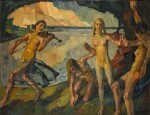European & British Art
European & British Art

Property from an Italian Private Collection
Leo Putz
Junges Leben (Youth)
Lot Closed
July 14, 01:33 PM GMT
Estimate
60,000 - 80,000 GBP
Lot Details
Description
Property from an Italian Private Collection
Leo Putz
German
1869 - 1940
Junges Leben (Youth)
signed Leo Putz lower right; signed, dated and titled Junges Leben / 1920-1921-1922 / Leo Putz on a label on the stretcher
oil on canvas
Unframed: 100.5 by 131cm., 39½ by 51½in.
Framed: 119 by 149.5cm., 46¾ by 58¾in.
Sale: Nagel Auktionen, Stuttgart, 1 July 2000, lot 753
Private Collection, Milan; thence by descent
Private Collection, Milan; thence by descent
This work belongs to the series of drawings, sketches and oil paintings titled Reigen (see Helmut Putz, nos. 646-652) and exemplifies Putz's freely painted Arcadian idylls of nudes and bathers by the water's edge. The setting for this and so many of Putz's paintings was the lake country around Schloss Hartmannsberg, where the artist and his family summered annually before the War, and again in the 1920s.
Putz was born in Merano, at that time in Austria-Hungary, moving with his family to Munich as a boy. He studied at the Munich Academy, and from 1891-92 at the Académie Julian in Paris under William Bouguereau and Jean-Joseph Benjamin-Constant. Despite his academic training, Putz was far more interested in the avant-garde subjects and impressionistic forms of expression being pioneered by his contemporaries, particularly Gauguin and Renoir, which would inform his own work.
On his return to Munich, Putz exhibited at the Munich Secession in 1895 alongside Franz von Stuck and with Franz Erler formed the avant-garde artistic group Die Scholle. He went on to become a Secessionist in Berlin and Vienna, where Gustav Klimt's figural painting had a profound influence on his work.
Putz was born in Merano, at that time in Austria-Hungary, moving with his family to Munich as a boy. He studied at the Munich Academy, and from 1891-92 at the Académie Julian in Paris under William Bouguereau and Jean-Joseph Benjamin-Constant. Despite his academic training, Putz was far more interested in the avant-garde subjects and impressionistic forms of expression being pioneered by his contemporaries, particularly Gauguin and Renoir, which would inform his own work.
On his return to Munich, Putz exhibited at the Munich Secession in 1895 alongside Franz von Stuck and with Franz Erler formed the avant-garde artistic group Die Scholle. He went on to become a Secessionist in Berlin and Vienna, where Gustav Klimt's figural painting had a profound influence on his work.
